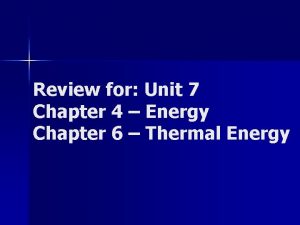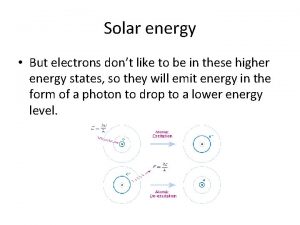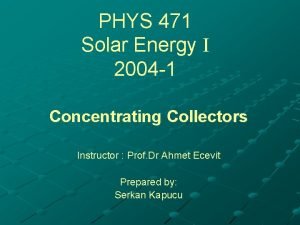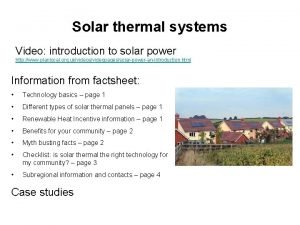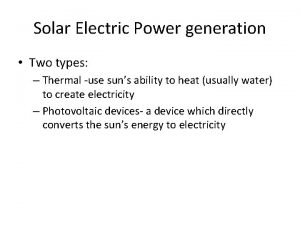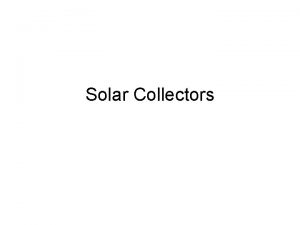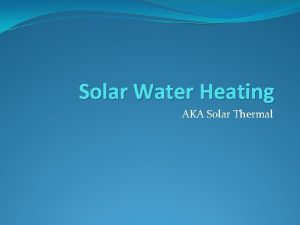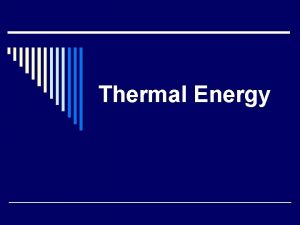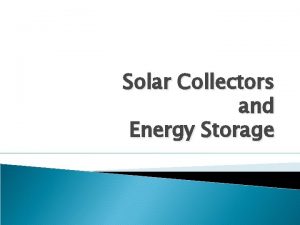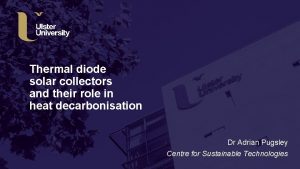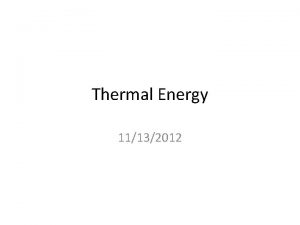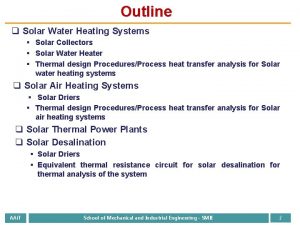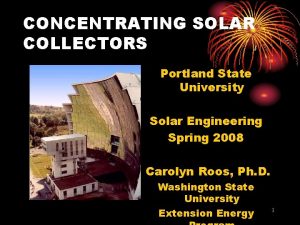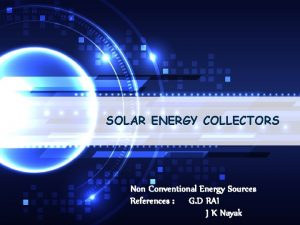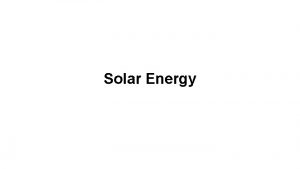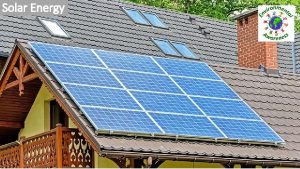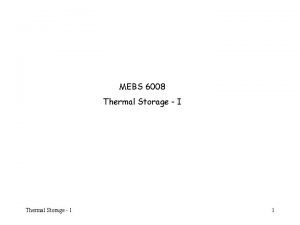Solar Collectors and Energy Storage Energy Storage Thermal




















- Slides: 20

Solar Collectors and Energy Storage

Energy Storage � Thermal � Electrical � Chemical � Mechanical � Electromagnetic

Energy Storage � Solar energy is intermittent in nature and hence needs storage. � The properties of application may not be similar to energy received from sun. For conversion of energy, storage of energy is middle stage. � Solar energy is available when not required and vice versa. � Storage of energy increases reliability. � Storage system is design factors: (i) Available solar radiation time. � (ii) Nature of load to be supplied from storage. � (iii) Cost per k. Wh of stored energy. � (iv) Size of generating system. � (v) Environmental and safety considerations.

Thermal Energy Storage � � � � Heating, melting or vaporization of material is used to store energy. Reversing the process releases the stored heat. There are two ways to store energy thermally: i) sensible heat storage and ii) latent heat storage. Storage of heat by raising the temperature of a material is called as sensible heat storage. Converting the state of a material to store energy is called as latent heat storage. The state of the material can be changed from solid to liquid or liquid to vapors, etc. The temperature does not change in this process. Both processes can be applied simultaneously. Water and rock (or pebbles) can be used to store energy through sensible heat process. Glauber’s salt (Na 2 SO 4 10 H 2 O) is a less expensive and readily available salt which can be used to store energy through latent heat process.

Thermal Energy Storage Sensible Heat Storage: (i) Materials whose state does not change for the � � � � � temperature encountered during storage process are used in this method. (ii) A simple equation to represent the sensible heat storage process is given below: Qs = (m Cp)s (T 1 – T 2) where Qs total thermal energy capacity for a cycle operating between T 1 and T 2. T 1, T 2 Temperature limits m mass of storage medium Cp specific heat of storage medium (iii) The ability to store thermal energy in a given container having volume V is given as: where ρ density of storage medium. (iv) Some of the materials used for such process are: water, rock, pebbles, iron, red iron oxide, concrete, magnesium oxide, aluminum oxide, silicon oxide, etc.

Thermal Energy Storage � Latent Heat storage: Heat is stored with change in state of material. � Change in state of material should be reversible. � Change in state of material will happen many times. � It should be economically available in large quantities. � The material must be chemically inactive. � Thermal conductivity of the material should be high. � The latent heat storage system is compact in construction. � Some of the materials used for latent heat storage are: Glaubers salt (Na 2 SO 4 10 H 2 O), Salt Eutectics, Fe(NO 3)2 6 H 2 O, paraffin, fatty acids, etc.

Electrical Storage Energy can be stored electrically through batteries, inductors or capacitors. � Capacitors: (i) The total energy stored in a capacitor is given as: � where V Volume of the dielectric � constant � E Electric field strength � Preferred dielectric material is mica. The capacitors suffer from leakage losses. The capacitor can store energy for a maximum of 12 hrs. The usage of capacitors for energy storage is uneconomical. �

Electrical Storage � Inductor: Energy stored in an inductor is given as: where Hm magnetic flux density � μ permeability of the material � High magnetic fields are required, which further requires strong mechanical structures. � Battery: It is an interconnection of multiple cells. Battery stores the electrical energy in electrochemical form. � Some of the batteries that can be used for energy storage are: lead acid, nickel cadmium, iron air, nickel hydrogen, zinc air, sodium sulphur, sodium chlorine, etc. �

Electrical Storage � The as: energy efficiency of a battery is represented � Cycle life of a battery gives the number of times; a battery is charged and discharged for given conditions.

Chemical Storage � Storage as fuel, reversible chemical reaction and as hydrogen. � Storage in the form of fuel: A reactant is generated by photochemical reaction. The photochemical reaction takes place due to solar radiations.

Chemical Storage � Hydrogen and oxygen can be separated through solar generated electrical energy. They can be then used in fuel cell to generate electricity. � Methane is formed due to anaerobic fermentation. Anaerobic fermentation takes place in presence of solar radiations. Methane can be used as fuel for variety of purposes. � Photosynthesis is also an example of storage of solar energy as fuel. Chlorophyll in presence of solar radiations produces carbohydrates with oxygen as shown below. � Carbohydrates can be used as a fuel.

Chemical Storage Reversible chemical reaction: Heat is absorbed during the chemical reaction and is released when the products of the reaction react to generate the reactants. � The temperatures of forward and reverse reactions are constant and different. The forward reaction takes place at higher temperature as compared to reverse reaction. � Such thermochemical systems are suitable for medium or high temperature applications. � Heat losses in such systems are less. � Some of the chemical reactions are: �

Chemical Storage � Hydrogen: Hydrogen can be used as a fuel. � DC power generated from solar radiations can be used to electrolyze water. Hydrogen produced in the process can be stored. � Hydrogen gas is stored in a pressurized container.

Mechanical Storage � Pumped hydroelectric storage: Electric power generated by solar energy drives a pump, which transfers water from a lower head to a higher head. � Water is allowed to flow down through a hydraulic turbine which drives electric generator. � The energy recovered is about 70%. � The method is cheaper. � The intermittency in generation of electrical energy is overcome. The electrical energy generated is directly ac.

Mechanical Storage � Compressed air storage: Solar energy could be used to drive a compressor and store air in a compressed form. � The compressed air could then be released through an air turbine to produce electricity. � The losses in this method of storage are negligible.

Mechanical Storage � Flywheel storage: A flywheel is a rotating mechanical device which stores energy as rotational energy. � The flywheel is driven by a motor operated through the power generated by solar energy. � The rotation of flywheel can be used to produce electricity. � The motor which drives the flywheel when solar radiations are available can be used as a generator when the solar energy is not available. � The efficiency of energy recovery is about 90%.

Solar Ponds

Solar Ponds � � � A solar pond acts as solar radiation collector like a large flat plate collector, and also work as thermal storage which can provide sufficient energy for entire year. The bottom of the pond is black and serves as an absorber. The layer of water above acts as an insulator rather than normal glazing and air space. In a large pond approximately 1 -2 m deep, the vertical gradient for salt concentration is maintained. The most concentrated and dense solutions are at the bottom. The salt concentration varies from 20 -30% at the bottom of the pond to almost 0% at the top. The salt concentration gradient disappears as the time passes. In order to maintain vertical salt gradient, fresh water is added at top through a horizontal diffuser, while slightly saline water is run off and concentrated salt water is added at the lower. Large amount of salt, approximately 50 g/m 2 -day, is required for maintaining the concentration level. Thus, salt is recycled by evaporating the saline water runoff.

Solar Ponds � � The solar pond has three distinct zones: (i) top convective zone, (ii) middle non convective concentration gradient zone and (iii) lower convective zone. The top convective zone has a depth of around 10 -20 cm. The temp is uniform, similar to air temperature and concentration is close to zero. The middle non-convective zone is deeper and is more than half the depth of the pond. In this zone, the temperature and concentration level increases with depth. It serves as an insulating layer, thereby reducing heat loss in upward direction and also as heat storage. The lower convective zone is similar in thickness to the nonconvective zone. The temperature and concentration are approximately constant in this zone. It serves as the main heatcollection as well as thermal storage medium. This zone is also referred as storage zone.

Solar Ponds Solar radiations reaching up to the black bottom of the pond is absorbed and temp at the bottom of the pond increases. Even though the bottom layer temperature increases, its specific gravity remains higher than that of the top layer due to the concentration gradient. The heat transfer through convection mixing is minimized. � The bottom layer of the pond has temperatures of 70 -85°C while the top layer remains at 25°C. � The hot lower layer is slowly withdrawn in a laminar flow pattern from the pond. � This hot water evaporates an organic working fluid in a heat exchanger and returns to the pond. � The annual collection efficiency of a solar pond ranges from 15 -20% which is lower than a flat plate collector. � Solar ponds are more economical than flat plate collectors. �
 Solar collectors are parts of a(n) ____.
Solar collectors are parts of a(n) ____. Classification of solar collectors
Classification of solar collectors Section 3 using thermal energy
Section 3 using thermal energy An inexhaustible source of energy
An inexhaustible source of energy Thermal transfer vs direct thermal printing
Thermal transfer vs direct thermal printing Accountability debt collectors
Accountability debt collectors What is hadees
What is hadees Civls
Civls Dmc debt collectors
Dmc debt collectors Allen v hannaford
Allen v hannaford Florida collectors association
Florida collectors association Concentrating collectors types
Concentrating collectors types Dick osburn
Dick osburn California solar initiative thermal program
California solar initiative thermal program Solar thermal
Solar thermal Solar thermal
Solar thermal Solar thermal
Solar thermal How are thermal energy and temperature different
How are thermal energy and temperature different Thermal energy and mass
Thermal energy and mass Wholesale solar module
Wholesale solar module Wind energy is indirect form of
Wind energy is indirect form of
